- Products & Solutions
- WaveFarer
WaveFarer® Radar Sensing Simulation Software
WaveFarer® is a high fidelity radar simulator that accounts for multipath and scattering from structures and vehicles in the immediate environment of a radar system as well as key atmospheric and scattering effects for frequencies up to and beyond 100 GHz. Applications include simulation of automotive drive scenarios, indoor sensors, and far field radar cross section (RCS).

EM Simulation Software Demonstrations
Let a Remcom expert show you how our software can benefit your application.
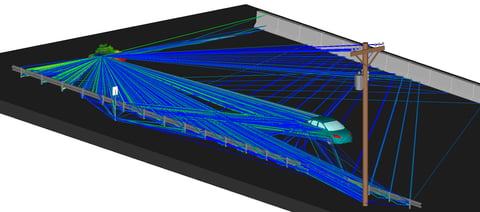
Near Field Propagation Method
Calculate scattering off target surfaces, including multipath interactions with ground reflections, using ray-tracing algorithms and physics-based calculations.
Read More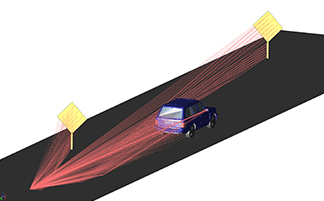
Targeted Ray Casting
Efficiently produce high fidelity returns by fully-illuminating targets.
Read More
Diffuse Scattering
Calculate contribution of scattering from rough surfaces to radar clutter.
Read More
Dynamic Scenario
Apply movement to radar sensors, target vehicles, and other scatterers in your drive test simulations.
Read More
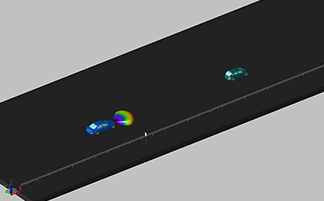
Scripts for Chirp Waveforms and Range-Doppler
Use WaveFarer scripts and utilities to simulate chirp waveforms, and post-process results to provide range-Doppler and other outputs.
Read More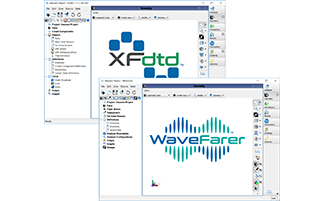
WaveFarer Applications
WaveFarer is designed to support all applications relevant for simulation and analysis of a radar system. For automotive radar, this includes evaluating radar sensor placement and target returns within a simulated drive scenario environment. For surveillance radar applications, this includes analysis of target radar cross section (RCS) and the impact of materials on results. For a variety of other radar and sensor applications, WaveFarer can be used to determine how the placement of a sensor and the presence of various nearby structures might affect the radar returns.

Automotive Radar
Simulation technology has advanced to meet more stringent design requirements for 24 GHz and 77 GHz automotive radar sensors including blind spot detection (BSD) and lane change assistance (LCA). Remcom offers an integrated approach from sensor design to drive test scenarios.
Automotive Radar
Radar and Scattering
Remcom’s software products are important tools for analyses including Radar Cross Section (RCS) computation, radar antenna design, and scattering applications.
Radar and Scattering-
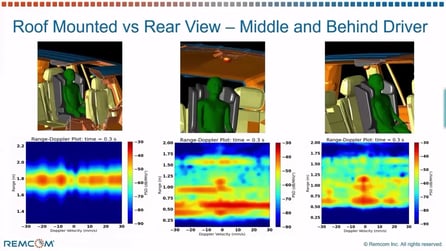
Webinars
Advancing Radar Sensing Simulation to Include Human Detection and Micro-Doppler in Complex Environments
In this webinar, we present a methodology for modeling radar returns and shadowing from humans, including the effects of breathing and heart rate on micro-Doppler.
Explore Resource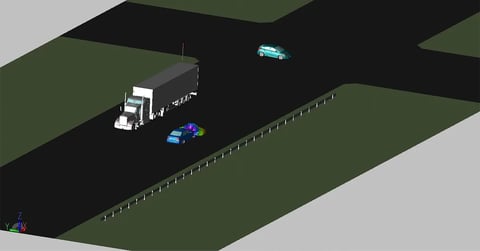
Webinars
WaveFarer Radar Analysis with Diffuse Scattering and Backscatter Through Walls
Learn about WaveFarer's new features for automotive and indoor radar applications, including diffuse scattering from rough surfaces such as roads and the ability to transmit through walls, windows, and more. Remcom will demonstrate these and other new capabilities using a sample drive scenario as well as an indoor mmWave sensor scenario.
Explore Resource -

Videos
Using WaveFarer Radar Simulation Software to Predict How Waves Propagate in an Indoor Environment
Using WaveFarer's included scripts, users can leverage Remcom's XGtd path viewer to generate ray path animations. This clip demonstrates the capability by showing backscatter in an indoor scenario, visualizing how waves diffract through doorways and penetrate walls.
Explore Resource
Videos
Diffuse Scattering in WaveFarer
WaveFarer’s diffuse scattering model increases the fidelity of the simulation by revealing how paths interact with rough surfaces, leading to additional clutter in radar returns.
Explore Resource
Videos
WaveFarer Automotive Radar Simulation Software
WaveFarer is a unique software tool created specifically for automotive radar sensor design and placement. It enables Tier 1 suppliers to virtually test and refine results earlier in the design process, improving installed sensor performance.
Explore Resource -

Publications
Animating Vital Signs in Radar Simulations: Comparing Physical Optics Against 28.5 GHz Channel Measurements
In this article, the author utilizes the PO solver available in Remcom's WaveFarer® radar simulation tool to simulate back-scatter from the chest of an animated human model and compare the predictions against 28.5 GHz measurements collected by the National Institute of Standards and Technology (NIST).
Explore Resource
Publications
Scalable Modeling of Human Blockage at Millimeter-Wave: A Comparative Analysis of Knife-Edge Diffraction, the Uniform Theory of Diffraction, and Physical Optics Against 60 GHz Channel Measurements
Human blockage at millimeter-wave frequencies is most commonly modeled through Knife-Edge Diffraction (KED) from the edges of the body shaped as a vertical strip. Although extensively validated in controlled laboratory experiments, the model does not scale to realistic 3D scenarios with many, randomly oriented bodies, on which multipath signals can be incident from any direction, not just normal to the strip. To address this, in this article we investigate computational electromagnetic methods based on raytracing.
Explore Resource
Publications
Range-Doppler Imaging Method Based on FFT-MUSIC for FMCW Radar
This paper proposes a range-Doppler imaging method based on FFT-MUSIC method for FMCW radar systems.
Explore Resource -

Brochures
WaveFarer® Radar Simulation Software Overview
WaveFarer® is a high-fidelity radar simulator that accounts for multipath and scattering from structures and vehicles in the immediate environment of a radar system as well as key atmospheric and scattering effects for frequencies up to and beyond 100 GHz.
Explore Resource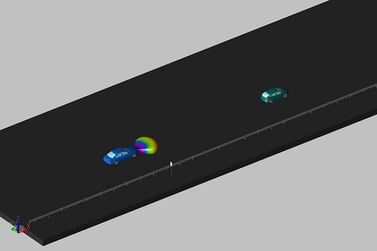
Brochures
WaveFarer® Radar Simulation Software Brochure
The automotive version of WaveFarer® is a high-fidelity radar simulator for drive scenario modeling at frequencies up to and beyond 79 GHz.
Explore Resource
WaveFarer Specifications
WaveFarer Capabilities
Contact us for additional capability information or to discuss your specific needs.
GUI
-
User-defined library containing Parts, Sources, Materials, and more
-
Full parameterization
-
Scripting interface with built-in editor
-
Macros
-
Custom project templates
-
Feature-based modeling
-
Live-updating results
-
Flexible, customizable project tree
-
Simulation queue
-
Interactive graph manipulation
-
Real-time error checking with feedback
-
Native multi-platform UI on Windows and Linux
CAD Import/Export
-
Import SAT/SAB files
-
Import DXF files
-
Import VDA-FS files
-
Import STL files
-
Import STEP files
-
Import IGES files
-
Import Pro-E files
-
Import CATIA V4 and V5 files
-
Import Inventor files
-
Export to SAT files
-
Export to STEP file
-
Export to IGES file
-
Export to CATIA file
-
Export to STL file
-
Export to DXF file
-
Editing of imported CAD objects
Physics Modeling
-
Three-dimensional ray-tracing with special features to target detailed target models
-
Near field scattering using PO and MEC
-
Multipath with roads and structures based on UTD
-
Diffuse scattering from rough surfaces
Materials and Environmental Effects
-
Extensive options for defining material properties:
-
Dielectrics and magnetic materials (finite thickness or half-spaces)
-
Perfect electric conductors
-
Perfect magnetic conductors
-
Perfect absorbers
-
Constant coefficients
-
Free space (air or vacuum)
-
Multilayer materials, combining any of the above
-
-
Diffuse scattering to capture additional clutter from rough surfaces
-
Atmospheric absorption
Geometry Generation
-
3D solid modeler
-
2D sketcher with constraints
-
Feature-based modeling
-
Arbitrary extrudes, revolves, sheets, and wire bodies
-
Complex geometry modification of created and imported geometries:
-
Wrap
-
Booleans
-
Chamfer edges
-
Blend edges
-
Shell solids
-
Remove faces
-
Offset faces and sheet edges
-
Remove holes
-
Thicken sheets
-
Loft
-
Stretch
-
Twist
-
Bend solid geometry
-
Project a sheet
-
Scale/translate/rotate/reflect/shear
-
Linear and circular patterns
-
-
Primitive geometric shapes:
-
Sphere
-
Cylinder
-
Cone
-
Cuboid
-
Torus
-
Pyramid
-
Prism
-
Frustum
-
Helix
-
-
Locators to easily reposition geometries
-
Cutting plane to reveal inner structure
Antenna Modeling
-
Transmitter/receiver sets defined through individual points
-
Built-in antenna types
-
Directional
-
Isotropic
-
Halfwave dipole
-
-
Far zone patterns imported from XFdtd
-
User-defined antenna patterns
Acceleration Options
-
GPU acceleration using NVIDIA’s CUDA architecture
-
Multiprocessor threading for unlimited cores
Visual Output
-
Radar Cross Section (RCS)
-
Monostatic or bistatic RCS
-
Option for High Range Resolution (HRR)
-
-
Received power
-
Path loss and path gain
-
Complex impulse response
-
Delay spread
-
Received power vs. angle of arrival or departure
-
RMS angle spread (arrival or departure)
-
Propagation path data export
Post Processing
-
Custom results using scripting API
-
Export results into MATLAB for post-processing
-
Export results into CSV text format
WaveFarer Versions Comparison
System Requirements
[1] Performance typically improves with more cores (or logical processors); however, many systems with large numbers of logical processors have limitations on sustained peak utilization.
[2] GPU must be a CUDA capable card and compatible with NVIDIA OptiX 4.1.0. Based on the release notes for OptiX 4.1.0 and the timing of its release, CUDA capable cards with compute capability between 3.0 and 6.1 should be supported. Contact NVIDIA support for specific recommendations.
XStream GPU Acceleration:
-
NVIDIA compute capability: 3.0 - 6.1 [2]
GUI - Supported Platforms:
- Microsoft Windows 7, Windows 8, and Windows 10, 64- bit
- Red Hat Enterprise Linux 7, 64-bit (and compatible systems)
Computation Engine – Supported Platforms:
- Microsoft Windows 7, Windows 8, Windows 10, 64-bit
- Red Hat Enterprise Linux 6 and 7, 64-bit (and compatible systems)
- Inquire for other platform availability.
The MPI module is available for the following platforms:
- Open MPI on Red Hat Enterprise Linux 6 and 7, 64-bit (and compatible systems)
- Inquire for other platform availability.
WaveFarer Professional Support
One year of Remcom Professional Support (RPS) is included with each product you purchase. Maintaining your license ensures that you will always have access to technical support and that you receive free product upgrades!
- Personal attention: speak directly with our engineers
- Product upgrades included
- Issue resolution, including escalation to higher management if necessary
- Toll-free phone and email support availability
Support is available from 9am-5pm Eastern Time, Monday-Friday.
